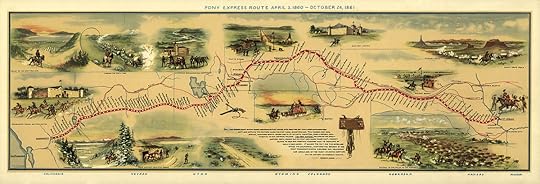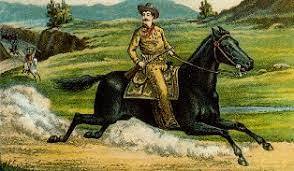The Pony Express
The Pony Express looms large in the lore of the American West, especially when one considers how short-lived it was. The Express, which was operated by Central Overland California and Pikes Peak Express Company, began delivering messages, newspapers, and mail on April 3, 1860. It was the quickest mode of delivering messages, and could get a letter from the Atlantic coast to the Pacific in about 10 days. By October 1861, the completion of the transcontinental telegraph had made the service obsolete.
The approximately 1,900-mile-long route for the Pony Express began at St. Joseph, Missouri, the far west terminus of the telegraph line. It roughly followed the Oregon and California Trails to Wyoming’s Fort Bridger, then followed the Mormon Trail to Salt Lake City, Utah. After that, it went to Carson City, Nevada Territory on the Central Nevada Route, then passed over the Sierra Nevadas before it reached Sacramento, California. From there, the mail went downriver by boat to San Francisco. About 186 stations were set up about 10 miles apart along the route. Riders changed to a fresh horse each station. They rode night and day, stopping after 75–100 miles. In emergencies, and when the next rider was unavailable, riders might ride two stages back-to-back, spending over 20 hours on horseback. Some of the stations had bunkhouses in which the riders could sleep. 
 The Pony Express Riders were all quite young, between 14 and 19 years old. They could not weigh over 125 pounds. At a time when unskilled laborers made between $0.43–$1 per day and bricklayers and carpenters could earn $2 per day, the riders received $125 a month, plus bonuses for fast completion of a route or for extraordinary dangers. The horses they rode were small, averaging 14.2 hands and 900 pounds, so while not strictly ponies, the name was appropriate.
The Pony Express Riders were all quite young, between 14 and 19 years old. They could not weigh over 125 pounds. At a time when unskilled laborers made between $0.43–$1 per day and bricklayers and carpenters could earn $2 per day, the riders received $125 a month, plus bonuses for fast completion of a route or for extraordinary dangers. The horses they rode were small, averaging 14.2 hands and 900 pounds, so while not strictly ponies, the name was appropriate.
One of the most famous Pony Express deliveries was done by Robert Haslam, who later went by the nickname “Pony Bob.” Haslam was born in London, England in 1840. In April 1861, he rode 13 mustangs on an eight hour ride that took him through 120 miles of Nevada Territory. His route went through hostile Paiute Indian country. According to his journal, he engaged in a “running fight” with warring braves that lasted for “three or four miles.” During that fight, a flint-tipped arrow pierced his arm and another broke his jaw and knocked out five teeth. Haslam was able to escape after shooting the horses out from under several of the Paiutes.  Haslam’s ride was part of a record-breaking delivery. While it usually took 10 days, this trip was completed in seven days, 17 hours. The delivery included Abraham Lincoln’s inaugural address, which helped the new state decide whether to stay within the Union or side with the Confederacy in the upcoming Civil War.
Haslam’s ride was part of a record-breaking delivery. While it usually took 10 days, this trip was completed in seven days, 17 hours. The delivery included Abraham Lincoln’s inaugural address, which helped the new state decide whether to stay within the Union or side with the Confederacy in the upcoming Civil War.
In recognition of his rapid and dangerous ride, the Express Company awarded Haslam $100. Although not delivering the packet might have changed the outcome of the war, Haslam was unfazed. He said, “ It’s nothing to get all fussed about. I’m a Pony Express rider. It’s all part of the job.”
When the Pony Express stopped, Pony Bob became and express rider for Wells, Fargo & Company. As the Pacific Railway and telegraph lines pushed westward, he took other routes in increasingly remote areas. When there were no more express routes, he moved to Chicago, where he died, destitute, in 1912. His tombstone was paid for by long-time friend and fellow pony express rider, William “Buffalo Bill” Cody. Jennifer Bohnhoff writes historical fiction for readers in middle school through adult. She learns a lot from her readers, and would like to thank Owen Currier for sharing the story of Pony Bob Haslam that was the inspiration for this blog.
The approximately 1,900-mile-long route for the Pony Express began at St. Joseph, Missouri, the far west terminus of the telegraph line. It roughly followed the Oregon and California Trails to Wyoming’s Fort Bridger, then followed the Mormon Trail to Salt Lake City, Utah. After that, it went to Carson City, Nevada Territory on the Central Nevada Route, then passed over the Sierra Nevadas before it reached Sacramento, California. From there, the mail went downriver by boat to San Francisco. About 186 stations were set up about 10 miles apart along the route. Riders changed to a fresh horse each station. They rode night and day, stopping after 75–100 miles. In emergencies, and when the next rider was unavailable, riders might ride two stages back-to-back, spending over 20 hours on horseback. Some of the stations had bunkhouses in which the riders could sleep.

 The Pony Express Riders were all quite young, between 14 and 19 years old. They could not weigh over 125 pounds. At a time when unskilled laborers made between $0.43–$1 per day and bricklayers and carpenters could earn $2 per day, the riders received $125 a month, plus bonuses for fast completion of a route or for extraordinary dangers. The horses they rode were small, averaging 14.2 hands and 900 pounds, so while not strictly ponies, the name was appropriate.
The Pony Express Riders were all quite young, between 14 and 19 years old. They could not weigh over 125 pounds. At a time when unskilled laborers made between $0.43–$1 per day and bricklayers and carpenters could earn $2 per day, the riders received $125 a month, plus bonuses for fast completion of a route or for extraordinary dangers. The horses they rode were small, averaging 14.2 hands and 900 pounds, so while not strictly ponies, the name was appropriate.
One of the most famous Pony Express deliveries was done by Robert Haslam, who later went by the nickname “Pony Bob.” Haslam was born in London, England in 1840. In April 1861, he rode 13 mustangs on an eight hour ride that took him through 120 miles of Nevada Territory. His route went through hostile Paiute Indian country. According to his journal, he engaged in a “running fight” with warring braves that lasted for “three or four miles.” During that fight, a flint-tipped arrow pierced his arm and another broke his jaw and knocked out five teeth. Haslam was able to escape after shooting the horses out from under several of the Paiutes.
 Haslam’s ride was part of a record-breaking delivery. While it usually took 10 days, this trip was completed in seven days, 17 hours. The delivery included Abraham Lincoln’s inaugural address, which helped the new state decide whether to stay within the Union or side with the Confederacy in the upcoming Civil War.
Haslam’s ride was part of a record-breaking delivery. While it usually took 10 days, this trip was completed in seven days, 17 hours. The delivery included Abraham Lincoln’s inaugural address, which helped the new state decide whether to stay within the Union or side with the Confederacy in the upcoming Civil War.
In recognition of his rapid and dangerous ride, the Express Company awarded Haslam $100. Although not delivering the packet might have changed the outcome of the war, Haslam was unfazed. He said, “ It’s nothing to get all fussed about. I’m a Pony Express rider. It’s all part of the job.”
When the Pony Express stopped, Pony Bob became and express rider for Wells, Fargo & Company. As the Pacific Railway and telegraph lines pushed westward, he took other routes in increasingly remote areas. When there were no more express routes, he moved to Chicago, where he died, destitute, in 1912. His tombstone was paid for by long-time friend and fellow pony express rider, William “Buffalo Bill” Cody. Jennifer Bohnhoff writes historical fiction for readers in middle school through adult. She learns a lot from her readers, and would like to thank Owen Currier for sharing the story of Pony Bob Haslam that was the inspiration for this blog.
Published on November 20, 2021 23:00
No comments have been added yet.



